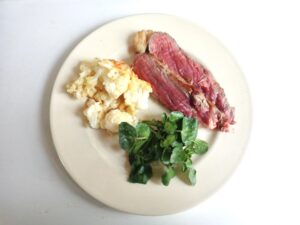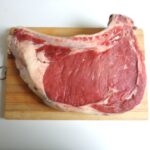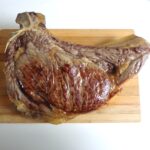
Rib of beef
Côte de boeuf is a single rib of beef. It is the same cut as an American ribeye steak, but with the bone included. Properly cooked, it produces tender, succulent slices of steak — perfect for a special occasion. Bone-in rib of beef is a common cut in France, not so common elsewhere. So the question is, if you’re not in France, how to choose the meat?
 In the States and Britain, rib beef on the bone is generally sold as prime rib. It comes with two or more bones included, often with the end of the bone exposed, and is served as a roast, not a steak. In order to make this French dish as the French do, you will have to convince your butcher to cut a single rib of beef, and not to trim away the fat. If that’s not possible, then you can use this recipe to prepare a thick-cut T-bone or Porterhouse steak.
In the States and Britain, rib beef on the bone is generally sold as prime rib. It comes with two or more bones included, often with the end of the bone exposed, and is served as a roast, not a steak. In order to make this French dish as the French do, you will have to convince your butcher to cut a single rib of beef, and not to trim away the fat. If that’s not possible, then you can use this recipe to prepare a thick-cut T-bone or Porterhouse steak.
A côte de boeuf is prepared in two stages. First the meat is pan-seared to seal in the juices. It is then roasted in a very hot oven for about 15 minutes for rare steak (saignant), which is how it is generally served in France. The time may be adjusted for very rare steak (bleu) or medium-rare (à point). The timing also depends on the weight of the meat. The côte de boeuf pictured here was 2-1/2 inches (6 cm) thick and weighed 3-1/2 pounds (1.6 kilos).
Many recipes for rib of beef suggest coating the meat with herbs like rosemary and thyme, or rubbing it with garlic prior to cooking. I wouldn’t suggest this. The classic version of côte de boeuf is prepared with no additional flavorings.
 Serve côte de boeuf with the veggie and/or salad of your choice — in the photo at top, it is served with cauliflower gratin and watercress salad. On a festive occasion, you could start with an elegant first course, such as homemade gravalax, oysters or foie gras, and follow up with assorted cheeses and/or fruit. And, yes, a festive dessert, for example chocolate-pear terrine or Kouglof, a holiday cake from Alsace.
Serve côte de boeuf with the veggie and/or salad of your choice — in the photo at top, it is served with cauliflower gratin and watercress salad. On a festive occasion, you could start with an elegant first course, such as homemade gravalax, oysters or foie gras, and follow up with assorted cheeses and/or fruit. And, yes, a festive dessert, for example chocolate-pear terrine or Kouglof, a holiday cake from Alsace.
One côte de boeuf will serve 4-6 people. Preparation takes about half an hour.
1 côte de boeuf (single rib of beef)
2 tsp. olive oil
1 tsp. butter
salt and freshly ground black pepper
Remove the beef from the fridge at least an hour before you begin in order to allow it to return to room temperature. Pat the meat dry with paper towels — this is essential to ensuring that the beef doesn’t stew in its own juices.
Preheat the oven to gas mark 7 (400 F, 210 C).
The rib may come with a large bit of fat attached. Score this fat from top to bottom in a diamond pattern. Do not cut into the meat.
Use 1 tsp. olive oil to oil your roasting pan.
Heat the remaining 1 tsp. olive oil to sizzling in a skillet large enough to accommodate the beef. Add the butter and continue heating until the pan is very hot indeed.
Sear the beef for about 3 minutes per side, until a dark brown crust begins to form. Important: When turning the beef, do not use a fork. Instead, flip it over using tongs or a spatula to avoid puncturing the meat. Just as important: Do not salt the meat at this stage. You will season the steak after it has been carved.
Transfer the seared beef to the roasting pan. The roasting time will depend on the thickness of the meat. With a thick rib, roast for 15 minutes for rare meat, 12 minutes for very rare and 18 minutes for medium rare. If the meat is 2 inches (5 cm) thick or less, roast for 12 minutes for rare meat, 10 for very rare and 15 for medium rare.
 After removing the beef from the oven, cover it loosely with a sheet of aluminum foil and allow it to rest for 5 minutes.
After removing the beef from the oven, cover it loosely with a sheet of aluminum foil and allow it to rest for 5 minutes.
To carve, first cut away the bone, then slice the meat. Season with salt and pepper.
Transfer to a serving dish and serve immediately, with the side dishes of your choice and a fine red wine. Serves 4-6.




